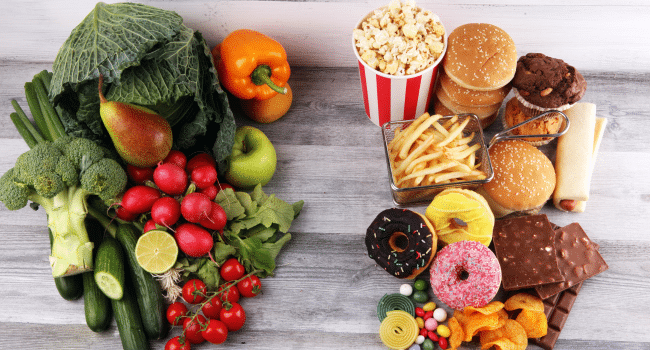Table of Contents
In the nutrition world, one debate always comes up: whole foods vs processed foods. And while everyone has heard those terms, most people still aren’t totally sure what separates the two—or why it matters. Let’s break it down in real terms, without fluff.
What Are Whole Foods?
Whole foods are ingredients that are as close to their natural state as possible. Think fruits, vegetables, grains, nuts, seeds, legumes, eggs, and minimally processed dairy. The common thread? They don’t come with a long list of additives, flavorings, or stabilizers.
For example:
- An apple is a whole food.
- Apple juice concentrate with added sugar and preservatives? Not so much.
Whole foods keep their original fiber, vitamins, minerals, and phytonutrients. They’re nutritionally dense, filling, and low in added sugar, sodium, and unhealthy fats.
What Are Processed Foods?
Processed foods are any foods that have been altered in some way during preparation. That includes everything from washing and chopping to adding preservatives, artificial flavorings, or emulsifiers.
Not all processing is bad. Technically, frozen vegetables and pasteurized milk are processed—but minimally so. The real problem comes with ultra-processed foods: packaged snacks, sugary cereals, instant noodles, frozen meals, soda, and much of what’s stocked in vending machines.
These tend to be high in salt, sugar, saturated fats, and artificial additives—and low in fiber and real nutrients.
Why It Matters
- Nutrient Density
Whole foods give you more bang for your buck in terms of nutrients per calorie. A sweet potato, for example, offers complex carbs, fiber, potassium, vitamin A, and antioxidants. A bag of potato chips? Mostly empty calories, with trans fats and sodium hitching a ride.
- Satiety and Cravings
Your body knows how to process real food. Whole foods digest more slowly and keep you fuller longer. Processed foods are designed to make you eat more (hello, bliss point), leading to overeating and sugar crashes.
- Long-Term Health
Multiple studies link high consumption of processed foods to chronic diseases like obesity, heart disease, type 2 diabetes, and even depression. Whole foods, on the other hand, support long-term health, better gut function, and lower inflammation.
Real-Life Comparison
| Category | Whole Food | Processed Version |
|---|---|---|
| Breakfast | Rolled oats with berries | Instant flavored oatmeal packets |
| Lunch | Grilled chicken with veggies | Frozen chicken nuggets |
| Snack | Handful of almonds | Packaged protein bars |
| Beverage | Water or green tea | Soda or bottled juice drink |
Notice a pattern? Processed versions often seem more convenient—but they trade health for speed.
The Convenience Trade-Off
Let’s be real. Not everyone has time to soak chickpeas overnight, or slow-cook quinoa on a Tuesday night after work. And that’s okay.
The idea isn’t to swear off processed foods completely. It’s to become intentional about them. Frozen vegetables, canned beans (rinsed), and plain Greek yogurt? Still solid choices. It’s the chips, soft drinks, flavored syrups, and shelf-stable junk that cause most of the damage.
Can Businesses Shift the Balance?
Here’s where it gets interesting.
Today, the food industry is increasingly intersecting with both technology and healthcare. From smart-labeling initiatives to nutrition-focused food startups, there’s a rising awareness about what we put in our bodies.
A software company in India, for instance, might build a health-tracking app that helps people log real meals, track added sugars, and get nudges to swap processed snacks for whole food options. That’s tech meeting real-life behavior.
Meanwhile, a pharma company might explore the gut-health link between processed food consumption and chronic inflammation, investing in research that connects dietary patterns with long-term wellness outcomes. Probiotics, personalized nutrition supplements, and even microbiome therapeutics are booming areas for pharmaceutical innovation.
In short: food choices aren’t just a personal thing anymore—they’re a societal and business-level concern.
How to Start Eating More Whole Foods
You don’t have to flip your entire kitchen overnight. Small changes stick better. Try these:
- Shop the perimeter of the grocery store first—produce, dairy, meat, eggs. That’s where most whole foods live.
- Batch cook basics like rice, lentils, and roasted veggies to cut midweek cooking stress.
- Read the labels. If the ingredients sound like a chemistry class, skip it.
- Snack smart. Replace chips with trail mix, candy bars with bananas + nut butter, or soda with lemon water.
- Upgrade one meal a day. Make breakfast whole food-based—like oats with seeds and fruit.
Processed Foods to Be Cautious With
Here’s a quick hit list of processed food categories that tend to do more harm than good:
- Sugary breakfast cereals
- Packaged instant noodles
- Flavored yogurts with added sugar
- White bread and refined flour products
- Processed meats like sausages and bacon
- Bottled soft drinks and energy drinks
- Ready-to-eat meals with long shelf lives
Again, it’s not about total avoidance. It’s about awareness.
For those who still include meats in their diet but want safer choices, options like certified halal sausages offer a balance—processed, yet regulated under halal standards. Choosing such products can help you retain convenience without completely foregoing oversight on ingredients, sourcing, and preparation standards.
When Are Processed Foods Useful?
Sometimes, processed foods serve a purpose. Athletes might need energy gels. Remote workers might appreciate the occasional protein bar during a crunch. A hiking trip might warrant freeze-dried meals.
Just don’t let them become your baseline.
Final Thoughts
Whole foods and processed foods aren’t just buzzwords—they reflect radically different impacts on your body. If you want stable energy, better digestion, and long-term health, prioritize whole foods where possible.
And here’s the twist: the shift isn’t just personal. Whether you’re a nutritionist, a parent, someone working in a software company in India, or even in R&D at a pharma company, what we eat is increasingly central to how we live, work, and age.
Start with your next meal. That’s where the change begins.
